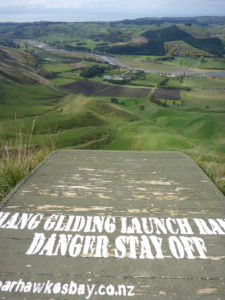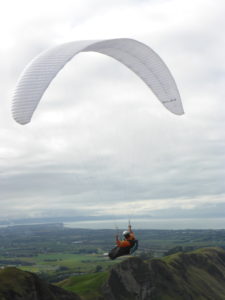It’s Nice to have a Plan
Tui was quite literally blown and washed into Gisborne by land just as Cook and his crew were after two months at sea, but for him it was the natives who gave him a turbulent time while for us it was the weather.
The initial interaction between Cook and the local Maori iwi led to a misunderstanding in which one or more muskets were fired and some Maori were killed. Subsequent arguments caused Cook to turn Endeavour about and as he left heading northward to first the bay next to Tolaga Bay and then Anaura that I have already mentioned where the welcome was positive, he damned this area with the name Poverty Bay, a measure of his feelings at the time and the fact it afforded him neither wood, fresh water or grass for the few remaining animals.
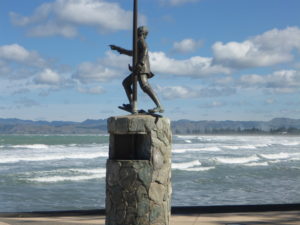
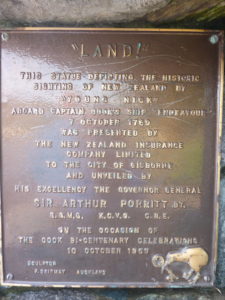
We took a more passive approach and registered into the Top 10 Holiday Park just behind where ‘Young Nick’ first spotted the shore of Gisborne and Cook made his disastrous landfall. Not a single tent was pitched and we took a very pleasant ensuite cabin for three nights, a short walk from the communal kitchen and views of the 5 metre waves that were breaking loudly onto the beach around the sweeping bay. All that night the outside walls of the cabin and the windows rattled in the 150kph winds on one side and the constant trundling by of the double timber lorries, rumbling laden one way to the docks and then rattling empty the other way back to the forests.
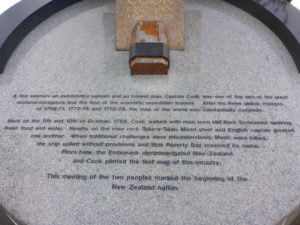
The next day rained hard most of the time so we deemed it ‘Museum Day’ and descended on the Tarawhiti Museum for some hands on experience we shared with numerous school groups of the models made by locals based on Leonardo Da Vinci’s inventions. In another gallery the equestrian paintings of Rosemary Parcell rejoiced in the elegance of movement so typical of these beautiful, curvaceous creatures (highly Googleable!).
The novel part of the museum that stands out in my mind was the two storied wheel house taken from the wrecked Star of Canada cargo steamer back in 1912. From the Captain’s vantage point we looked up and down the muddy river and spotted the first signs of blue in the heavens above.
Gisborne is at the mouth of where two rivers meet the sea and the weather took a turn for the better two days after our arrival so we walked to the top of Kaiti Hill for a fine view of the surf and surrounding country. The docks were busy stacking lumber ready to be loaded once the weather improved. The man made entrance to the protected harbour seemed mighty narrow for the passage of an ocean going ship and manoeuvring space for tugs would be very limited. Unfortunately we missed out on seeing how it was done.
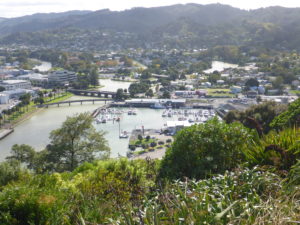
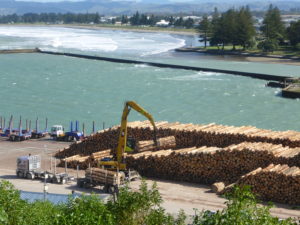
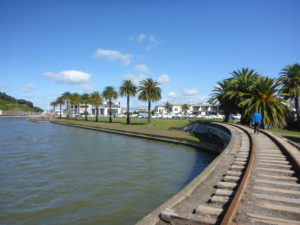
Instead we took a few minutes to look around the memorial garden carefully laid out to record Cook’s landing and filled with the plants that, picture this, Mr Banks must have grabbed in haste while Cook and his officers were trying to befriend the Maoris.
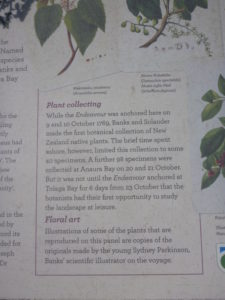
It was evident from advertisements and brochures that Gisborne is a highly cultured area and creative activities abound across all ages and races which can be enjoyed by the public.
With the weather once again on our side we sped up the Wharekopae Road to the Rere Falls and rockslide. It was great travelling at this time of year as autumn was approaching and the high season was at an end so we had this place to ourselves. No long walk to the falls this time, we just drove Tui into the soft surface carpark and stepped out to find pink fleshed windfall apples, sweet and juicy, and ripe walnuts on the ground ready for our gathering. The falls, though smaller than those at Whangarei, were a continuous wall of water for their entire width.
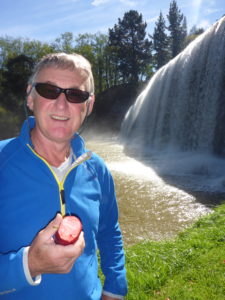

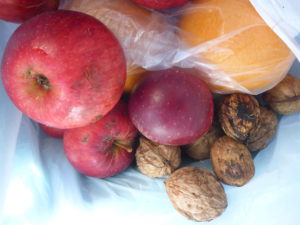
For $10 a visitor could sit bum in the middle of a tractor inner tube and slide down a rock surface on a thin film of water and splash into a pond at the bottom of the rock slide. We could have done it for free but decided imagining the experience was enough.
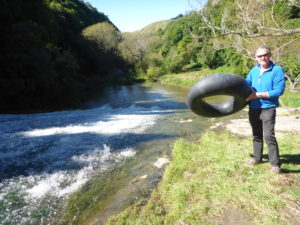
A visit to New Zealand’s national Arboretum at Eastwoodhill was in fact the third item on our days plan after the Hill at Gisborne and the Rere Falls and Slide, so we were doing well. Started by farmer, W. Douglas Cook in 1910 this 135 hectare site has blossomed into the arboreal haven it is today as much by accident as by design. In the four years before leaving to serve in the First World War Cook planted Eucs, Pines and orchard trees and cuttings and seeds from friends all over the North Island. It was not until after his recuperation from war time injuries in England that he learned about aesthetic tree planting in the gardens of stately homes and botanical gardens and through his friendship with the director of Kew Gardens.
The friendly and enthusiastic lady at reception took one look at us and sent us off on the longest and steepest walk in the park to get the full appreciation of the area. As we climbed higher up the hills around the park we noted that the surrounding hills were barren by comparison. Denuded of native forest and over grazed by stock, evidence of erosion scarred the hillsides around the mono culture commercial plantations of dark green trees.
Below us the autumn colours were starting to tint the leaves all shades of warm yellows and coppers on these now mature trees. I thought of Cook’s investment in the future. He could see the value of creating this repository of plant life after the threat of nuclear holocaust in the northern hemisphere. Although this never happened Cook started to be asked by people from whom he had originally obtained plants if he could send them some of the same back to replace those lost through pollution and loss of habitat.
Eastwoodhill is now a trust and in 2005 was recognised as The National Arboretum of New Zealand. We came across two New Zealand couples on holiday together. One of them was gently nudging big ripe apples from a mature tree and we chatted for a while as we munched the juicy fruit from one of the apple trees Cook had planted for the refreshment of passing sheep drovers. I learned that the giant quince Jeanie had given me and I had made into jam are Chinese Quince, bigger and milder than the tart little ones I have used in the UK.
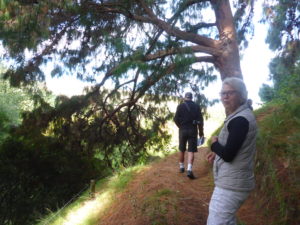
Our journey away from this haven and down the dry, barren valley brought us onto a coastal plain of sheep trimmed vineyards skirted by sweet smelling lavender hedges. The smell of oranges, sacred kingfishers on telegraph lines. Kanuka and Manuka groves peppered with pastel coloured hives and Pampas grass thrived on regenerating hillsides left crinkly shaped from the feet of a thousand grazing sheep. Small herds of shiny coated cattle ranging over big areas of naturally green grass; this truly is a land of milk and honey.
The fourth item on our day’s plan was to whet our whistles at ‘our local’ the Sunshine Brewery, conveniently just outside the gates of our camp. Just like Cook with his inspiring tree estate two young lads were sitting one day, waiting for the wave and discussing what they should do in life, when they came up with the idea of brewing some decent beer. That was nearly thirty years ago and their brewery is now the longest established independent craft brewery in the land and they are keen to remind us that many good days of surfing have been lost in sharing the love of good beer within the sounds of the surf on Waikanae Beach. Well the least we could do was enjoy some don’t you think.
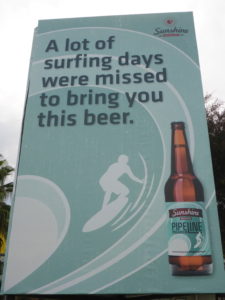
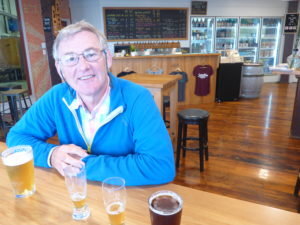
The fifth and last item on our list was to buy some fish and chips in the chippy opposite our camp and eat it while watching TV in our cabin. We arrived at the shop as an apologetic lady was washing the floor! So we had soup and a sandwich instead while watching the news of the latest cyclone ‘Keni’ unfolding. Combined with the last cyclone two weeks ago the effect was to ‘sink’ much of Fiji underwater.
Our non-cyclone storm had raged over Auckland at 213kph, causing trees to fall and ‘outing’ the electricity to one hundred thousand homes, so we and hopefully Zoonie, got off lightly.
Are You Superstitious?
Friday 13th April
South to Napier
Ever since Zoonie’s near sinking thirteen months and one day ago Rob and I have held the hope that somehow before we leave these fair shores we would be able to come and visit Napier and its surrounds as we had originally planned to do. But back then we had to drive non-stop back to Whangarei instead of turning right to Hawke’s Bay.
Completed and opened in 1966 State Highway 2 stretched south from Gisborne over the flat plains of Gisborne County. Grapes, fruit especially kiwis and frijoas and lettuce covered the fertile soils. Fields of muscular Angus Bulls and goat farms heralded a change in livestock farming.
The big dairy cattle farms are now changing their future plans. Smaller herds of dairy cattle, less use of fertilisers, careful management to prevent harmful run offs into the rivers and the practice of milking sheep instead are now all on the cards and in places underway.
With new environmental knowledge we know that in areas where forest has been cleared causing a mini climate change to a drier one there is now a shortage of water lying in the ground necessitating expensive and wasteful irrigation schemes.
We stopped in Wairoa which nestles against the wide and winding Waiau River. The town centre was full with empty shops and decaying buildings. Its boom town past is evident despite the optimistic commentary in the Travellers Brochure. There was much in the way of outdoor activities to do in the area and no doubt it is a humming centre in the high season and we would certainly like to return one day to the elusive inland lake known as Waikaremoana.
The town centre museum had a good exhibition about Maoris and the New Zealand Land Wars of the 1860’s which held our attention for about an hour.
Then we were back on the road through deep gorges with grey wacke walls. We sped past the Mohaka Railway Viaduct, the tallest in Australasia at 96 metres high and 278 metres wide, on through white pine forests and approached Napier with orchards and vineyards bordering the road.
At 13.14pm precisely we arrived in Napier and to make up for the meagre supper of the previous evening we tucked into fish and chips at the Irish Pub on the water front in Aruriri, once the fishing village next to the town.
Determined to pitch our little tent this time we found Kennedy Park, unbeknown to us at the time rated as one of the best independent parks in NZ. The best aspects to us were the reading room and internet access. Soft settees for our weary bums in the evenings and the unlimited fast broadband internet “You don’t need a password” the lady in reception had said which meant we could sit on our self-inflating mattress in the tent and surf to our hearts’ content without getting wet!
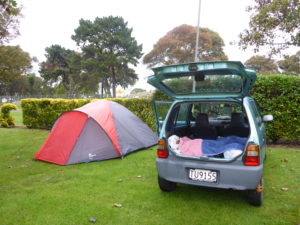
To fill the day we drove Tui up Bluff Hill for an excellent view of the docks, with a ship being dragged in with tugs and tree trunks galore being arranged, re-arranged and loaded onto carriers. The bluff is covered in up market homes, many of them survivors of the 1931 earthquake, being made of wood they flexed with the movement. Imagine standing on your balcony watching your town crumble infront of your eyes.
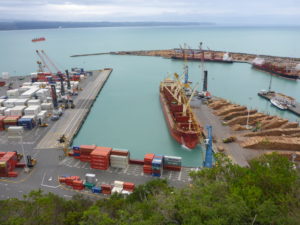
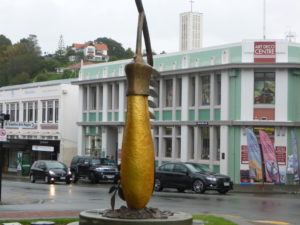
In Speights Brewery back on West Quay, Ahuriri, we formulated a plan for the brief time we would be here. In the morning the next day we’d ‘do’ the Museum and at 2.00pm meet Pam for our Art Deco Tour.
Museums often come up with surprises in the way of their temporary exhibitions and this one was no exception. Some of you more mature readers may remember the TV series ‘The Forsyte Saga’ in which Nyree Dawn Porter played Irene, Soames wife who loved to hate him. Well she was born here five years after the earthquake and started a ballet school while still a teenager. Her rise to fame came when she left for London and here legacy is her love of the elegant use of the body in the form of ballet and acting.
In the Maori room videos of the importance of dance and songs to the local iwi showed how well Maori landlords and Pakeha lived together in unity and friendship.
A moving exhibition to both of us was the account by five earthquake survivors of the events of that fateful day on February 3rd 1931. One man, a boy at the time, had been trying to get his Aunt’s dairy herd into the parlour for milking the day before the quake. Well they would not move forward to go indoors, instead skewing from side to side. His Aunt came outside and immediately knew why. She looked to the sky and said “There is going to be a big earthquake soon!”
A Maori lady with her young girfriends at the time started the long task of helping to pull live and dead victims from the rubble. A stomach turning task as the weather was hot and the job time consuming. Even 70 years of living later in recalling the tragedy her bottom eyelids held her tears from falling “We tied handkerchiefs over our faces, the job just had to be done, it had to be done.”
After lunch at The Drunken Whale back on the Quay we were energised and ready for Pam’s passionate and entertaining tour around the Art Deco Town Centre.
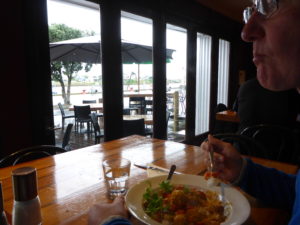
Black and white photos showed the town before the quake. Substantial neo classical and colonial architecture cluttered the narrow drafty streets. The pavements were dark and cool as the high rises loomed above casting shadows. Telegraph poles with hundreds of lines strung between added to the oppressive but typical city centre scene.
A gang of steeplejacks were working from scaffolding on the finishing touches of a brand new church when suddenly the new roof infront of them crumbled inwards and they watched from their lofty and flexible perches as the city fell down before their disbelieving eyes. Imagine their feelings as they scrambled down to the street. The home they knew so well collapsed in less than three minutes.
At the same time the RNZN ship Veronica had just cast 6 mooring lines ashore as she berthed alongside the quay. In the event she and the quay were lifted 2 metres into the air, five of her lines broke and then she was dropped down onto soft mud as the whole former lagoon rose in an instant to become new land. The ship was unharmed and the radio operator was crucial in initiating the rescue initiative as they were the only ones with a radio. Her entire crew went into town to assist with rescuing victims.
In those days all pharmacies had live flames used to seal the wax around medicine bottle lids and it was these that led to dozens of fires starting and eagerly burning the tinder dry wooden buildings over the next 48 hours.
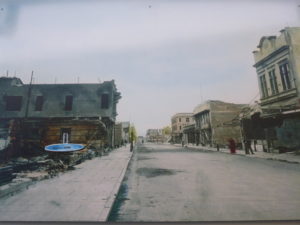
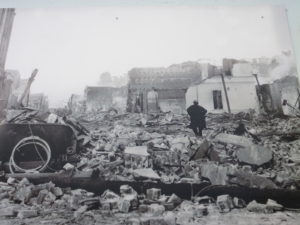
There was no insurance against earthquake damage then so the rebuilding started almost straightaway without the time hindrance of claim processing. Like a phoenix rising from the ashes Napier was rebuilt along completely different lines in just 22 months. Four architectural styles were used in an avant-garde new fusion of civic design.
The 1925 Exposition des Arts decoratif in Paris provided the original ideas for fresh clean lines and a new boldness and confidence which allowed utility to be dominated by aesthetics. Such optimism was surprising and yet necessarily uplifting for this damaged town while the rest of the world was in a Depression at the time. The Spanish Mission style with pretty pantile roofs and domed windows and occasional Maori curves absorbed the best of the past and the Modernist and Prairie styles reflected the optimism for the future.
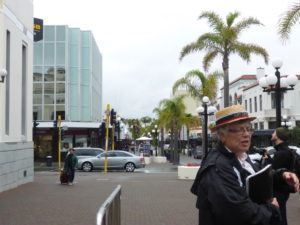
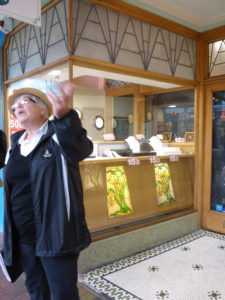
The overall effect reminded me of Worthing where I was born and bred and to an extent Brighton just along the coast. The bandstand area on the wide promenade was an Eastbourne lookalike.
Muted, pastel colours accentuate the styles of the mouldings which are futuristic rather than grand. It was all very attractive and practical. Buildings could only be built to two floors to withstand future quakes and they were set back six feet giving wide pavements and allowing light and warmth into the sidewalks.
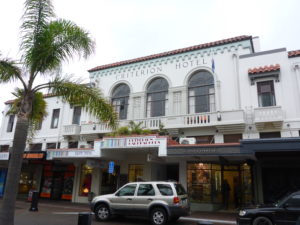
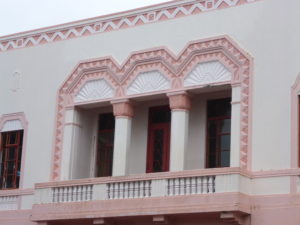
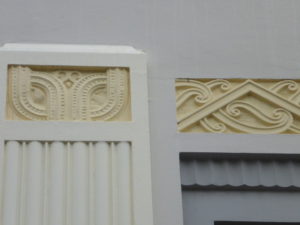
The shop canopies had no vertical supports instead being suspended from steel cables attached to the walls above. The corners were taken off buildings giving a pleasant angle for the pedestrian to negotiate. You may be familiar with the use of patterned glass held with lead to decorate shop windows set into walls of terrazzo, marble and granite chips set in concrete and polished smooth to create pretty and durable shades of pink and green.
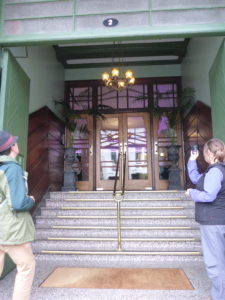
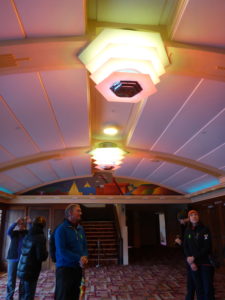
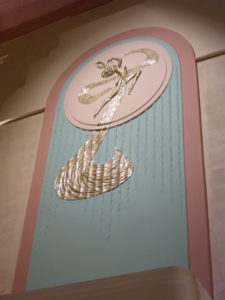
Sadly some featureless anti deco sixties multi-storey buildings have crept into the midst at the expense of style and beauty and as Pam pointed out if it wasn’t for the birth of the Napier Art Deco Trust, of which she is an enthusiastic volunteer and member, many more of Napier’s renaissance buildings would have been demolished.
“So Pam have there been any significant quakes since 1931 to test these buildings?” I asked.
“There are little quakes all the time but we don’t usually feel them.” That very night a category 5.2 earthquake rumbled away 22km below the earth surface just south of Napier. Did the earth move for us in our little tent? Just a bit.
South to Hastings and Te Mata Peak
Fresh Produce, Birdman and Birdwood
The attraction of Hawke’s Bay as a place to live in another life is reinforced by a visit to New Zealand’s largest and longest running Farmer’s Market, (so says the tourist brochure although the numerous stallholders I asked could not substantiate this) held imaginatively at the A & P Showgrounds. I say imaginatively because if the sun shines the stalls are set up outside but if the skies are grey, as they were for us, the stallholders just dive into the vast dry area underneath the stand.

It was on a par with the indoor market at Mindelo, Cape Verdes and I just love the colour and variety of the produce and the human imput is a matter of degree. From harvesting the all local food, cleaning and trimming it for neatness to cooking and baking all kinds of breads, cakes, preserves and sweets.
The Swiss Chard or Sea Kale Beet as it is also known and the Jerusalem Artichokes brought back memories of my happy days of vege gardening in Yarmouth on the Isle of Wight. The chard was the only lettuce/brassica like vegetable I could grow without it being eaten into a lace doily by the caterpillars and artichokes make the most delectable earthy flavoured soup known to woman. As I type the ones I bought are now in soup form and sitting in a pan ready to start off the diner we are having with Merv and Jeanie up at Shirley and Max’s retreat this evening. Remember the concrete house with the rounded corners overlooking Limestone Island?
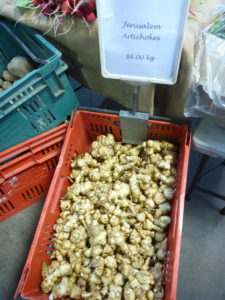
A short drive down the road brought us to the truly delightful centre of Hastings. In the UK Hastings is along the south coast road from Brighton and Eastbourne so one would expect to see Art Deco architecture if the designers out here heralded from those parts and we were not to be disappointed, so maybe they did come from home.
Locally Hastings is viewed as the poor brother of Napier, however I could not disagree more. I could easily spend a week or more in the area. We were there only briefly but in that time it was clear to see the modern day adherence to the Renaissance styles is totally loyal, unlike Napier. The I-Site itself is housed in a typical A-D building and the photo shows not only the cut off corner but also the Terrazzo walls, Australian pressed tin pattern of the ceiling underneath the canopy and the decorative use of glass shapes in the windows.
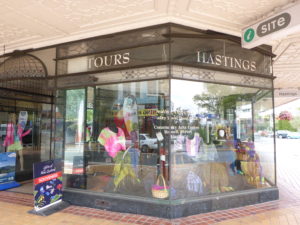
See also the wide and light, even on a dull day, pavement outside Westerman’s Café where we supped a coffee and the modern elegantly curved lamppost infront of the Cinema with its clean bold lines. We came away well aware of all that we had missed.
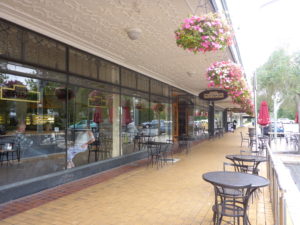
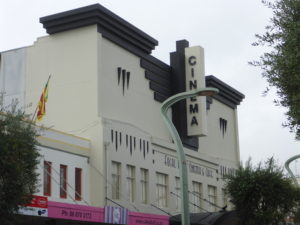
We were hoping the low cloud would lift as the day went on so we could take Tui, or Tui would take us up Te Mata Peak for a 360’ look around the area. So we delayed that climb until we had visited Birdwoods, home of Bruce and Louise who were ousted from their Zimbabwean farm 15 years ago. I wondered who was ousted from the land in the first place.
They have remained loyal to the skills of the local sculptors in the old home country and twice a year return there to buy up many pieces sculpted in green opal stone and re-cycled metal and display them in the pretty shopfront that is their garden. The work of New Zealand and Hawke’s Bay artists is also on sale. It is more economic for Americans to travel here and chose their items and have them shipped home than it is to buy them in New York.
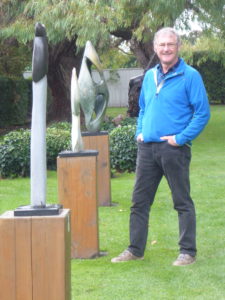
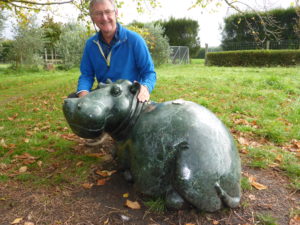
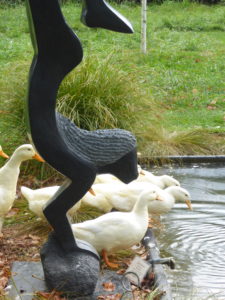
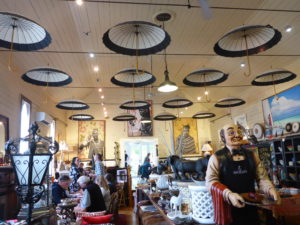
Can you spot the three giraffes? We didn’t take time for a ‘renowned’ tea or lunch as we were engrossed in the lovely African animals and the clouds were obediently ascending from the Peak, so off we went for our view of Hawke’s Bay and a nosey down at the homes of the rich.
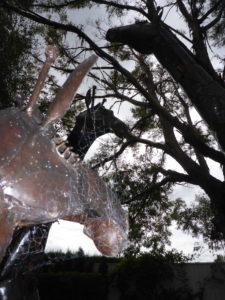
I don’t think I would ever be inclined to try hang-gliding unless someone held a gun to my head but I can see the appeal. Ours buzzed us as he swum the sky around and overhead which was fun until an elderly joker said in a loud voice “If God had meant us to fly he’s have given us wings.” He might have been trying to wind us up so I replied with a smile,
“Well he did and he’s wearing his!” Looking at the man-bird. Had it not been for the fact I think the lady next to me was his daughter I might have gone on to say, ‘Walk up did you? For we were not born wearing cars were we?”
